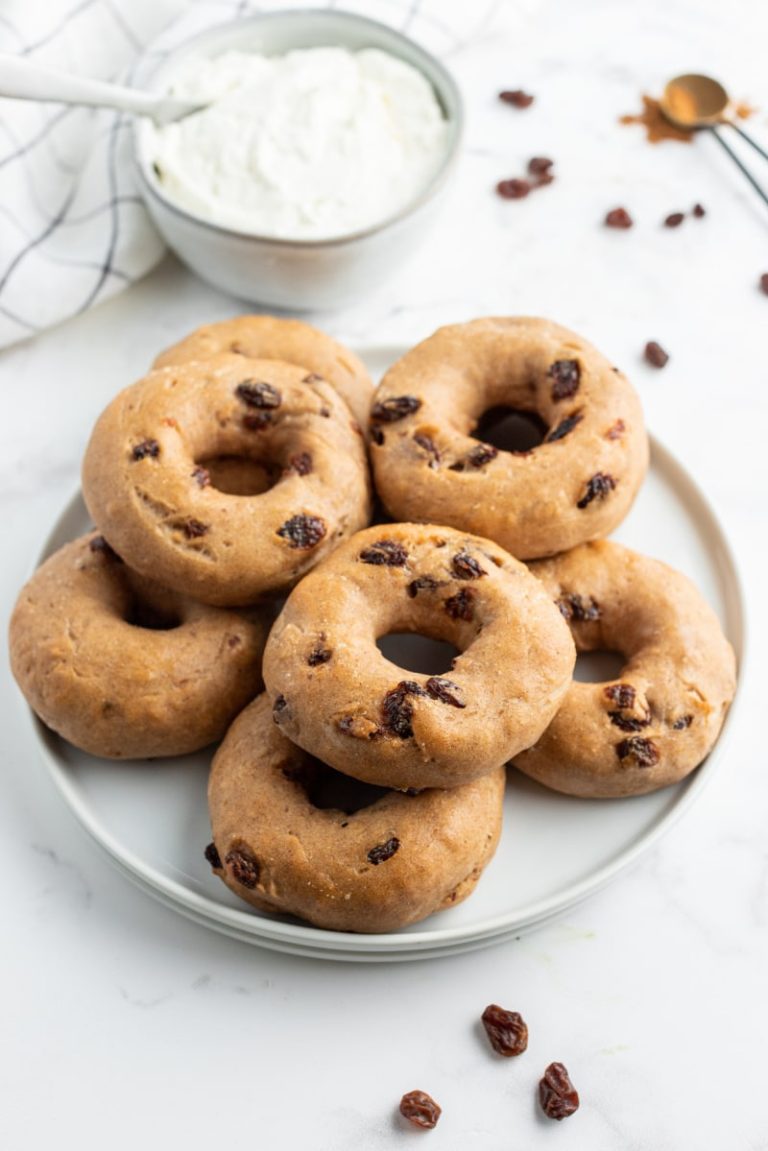ADVERTISEMENT
Instructions
Preheat oven to 375°F. Place parchment paper on a baking sheet. Lightly coat with cooking spray to prevent bagels from sticking.
In a large bowl, use a sturdy spatula to combine the self-raising flour, cinnamon, and 1 CUP YOGURT until the mixture forms a shaggy dough. Add additional yogurt until you have a good consistency that is not completely sticky. You may or may not need to add an additional cup of yogurt to the dough. It depends on the moisture content of the yogurt you are using. Work in the raisins. Pour the mixture onto a lightly floured work surface. Knead the dough by hand for about 5 minutes, until the dough is smooth and elastic. If your dough is sticky add more flour or use less yogurt. (see Recipe Notes below for tips).
Divide the dough into 8 equal parts. Form a ball with each portion of dough. Use your thumbs to make a hole in the center of each ball. Pull and stretch gently until the dough is a uniform size. Repeat with remaining rounds. Flour your hands as needed.
Place the shaped bagels on the prepared baking sheet. Mix egg wash by whisking egg, salt, and water in a small bowl until smooth. Spread beaten egg mixture over bagels. Add a few more raisins to the top of the bagels, if you like.
Bake for 20 to 22 minutes, rotating the baking sheet halfway through baking. Remove from oven. Increase the oven temperature to 450 degrees F. Return the baking sheet to the oven and bake for another 3 to 4 minutes until the tops of the bagels are golden brown.
Eat it hot right out of the oven or let it cool and store in a resealable bag or tightly closed container for up to 24 hours. If you keep them refrigerated, they should stay good for up to 3 days. If you want to freeze them, wrap them individually and let them thaw before opening and toasting.
Notes
To make homemade self-rising flour: Combine 2 cups all-purpose flour, 1 tablespoon baking powder, and 1/2 teaspoon fine sea salt.
To make a bagel with more “chew,” substitute AP flour for bread flour in the homemade self-rising flour recipe mentioned above.
Use thick strained Greek yogurt. Stay away from those labeled as “Greek-style” yogurt, as they tend to have more moisture. Suggested brands include: Fage Total 0% Greek Yogurt and Stonyfield Greek Yogurt. If there is any liquid in the yogurt, it should be drained before using. Thick Greek yogurt works best!
The dough can also be mixed in a stand mixer using a dough hook. Add the ingredients to a bowl and mix on low speed until a shaggy dough forms. Increase to medium speed and knead until the dough no longer sticks to the sides of the bowl.
As you rotate the baking sheet, check to see if the bottoms of the bagels are browning too quickly. If so, simply place another baking sheet under the current baking sheet and continue baking.
Nutrition
Serving: 1 bagel, Calories: 172 kcal, Carbohydrates: 34 g, Protein: 7 g, Fat: 1 g, Saturated fat: 1 g, Trans fat: 1 g, Cholesterol: 24 mg, Sodium: 21 mg, Potassium: 142 mg, Fiber: 2 g, Sugar: 4 g, Vitamin A: 35 IU, Vitamin C: 1 mg, Calcium: 15 mg, Iron: 1 mg
ADVERTISEMENT
